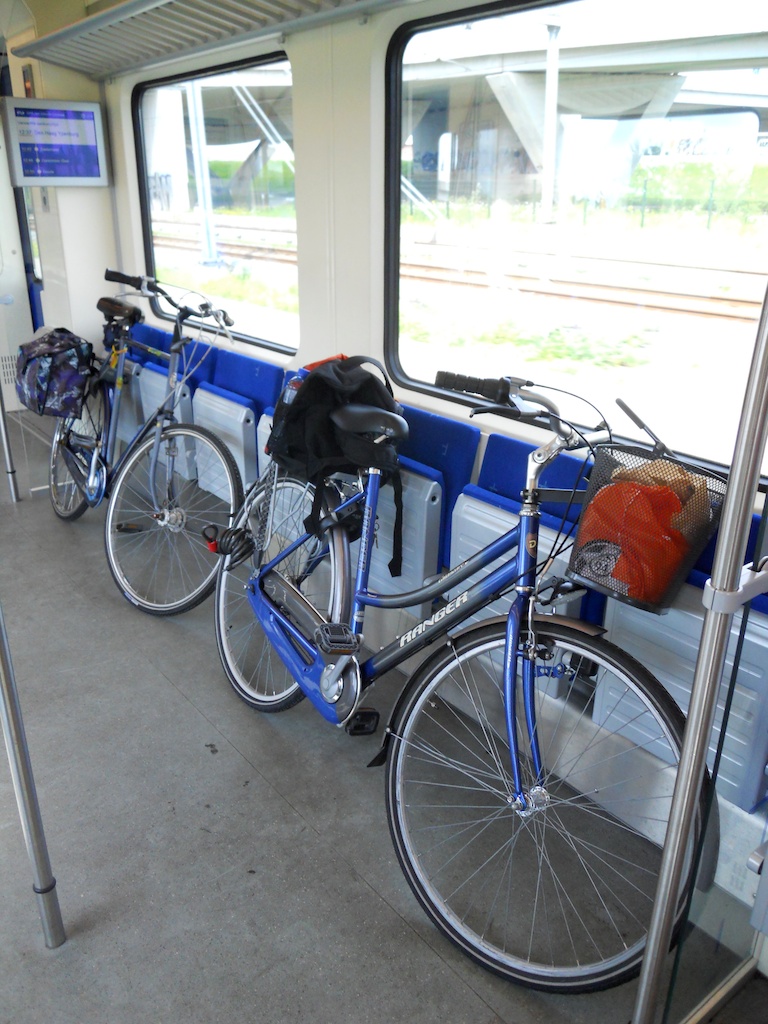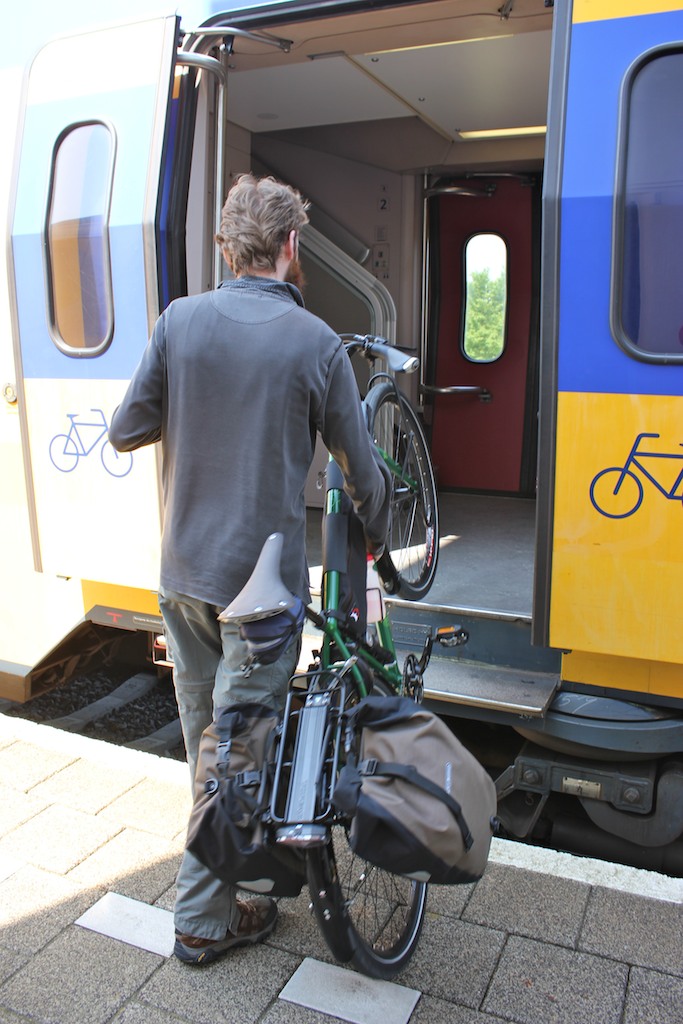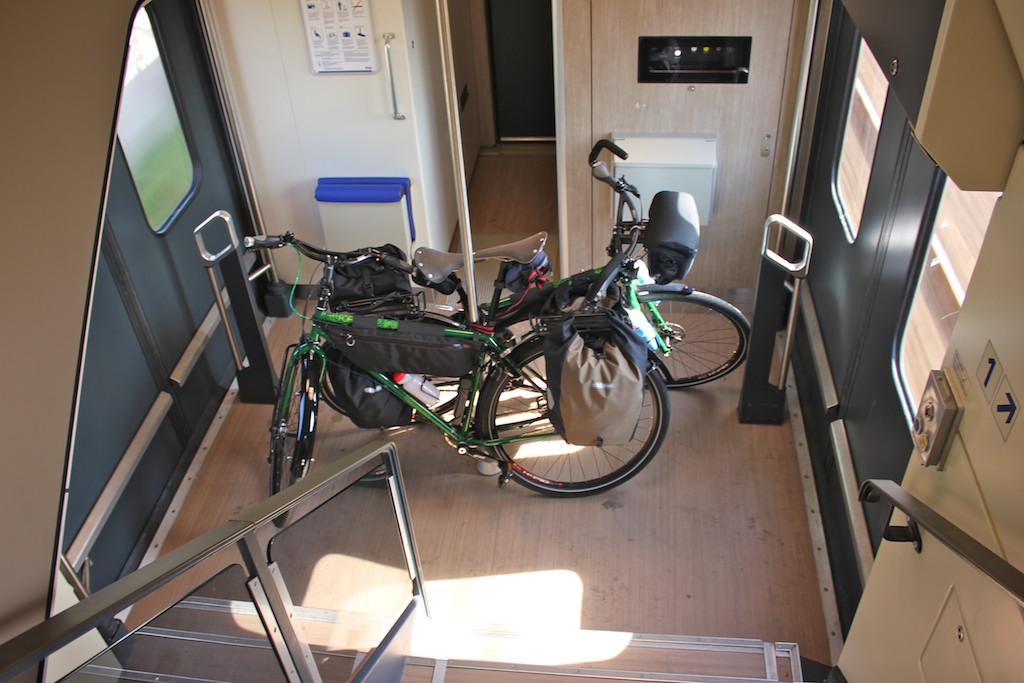Taking your bicycle on the train in The Netherlands
A practical guide
In the Netherlands it is fairly common to take your bicycle on the train, nevertheless it can still be quite a hassle and there are some things that you need to take into account. Having taken everything from a folding bike to a bunch of recumbent bicycles on the train several the years I will share my experiences here.
Rules
The largest railway company is NS, you can buy a day ticket for a bicycle for 6 euros (2013). It is valid the whole day for any destination within the country as long as you have a valid ticket for yourself as well.
Some regional trains are run by some other companies like Arriva, Syntus, Connexxion and Veolia. An NS train ticket for bicycles is also valid for these trains. The rules between the companies vary slightly, but are mostly similar.
Unlike some other European countries you do not need to make a reservation for your bicycle, even if you wanted to there is no way to guarantee yourself a spot.
At the moment (2013) it is not possible to take your bicycle on international trains to for example Paris. Cycling organizations have been asking for this for years, but their efforts have not yet paid off. However, you can still take the regular train up to the border and then get on the Belgian or German train there, but they have different rules for taking on bicycles.
During the summer months you can put your bicycle on the train all day long. The rest of the year it is not allowed to take the bicycle on the train during rush hour, which is the whole morning until 9:00 and then again from 16:00 until 18:00 hours. This means you are not allowed to take it on a train that leaves at 8:59, although you can get a fine the conductor will usually show some leniency, just don't piss them off.
Every train has at least one bicycle storage area, the doors of the compartment are marked with a bicycle symbol. Some trains have two or more.
There are different train models. The best bike storage spaces are the ones with the seats that fold up, they are more spacious that the other kinds.
If there are already bicycles in there, try and find out who it belongs to and ask at what stop they are getting out, so that you can move your bike when they need to leave. If you are getting on at the same time with some other cyclists it makes sense that the person who goes furthest puts his bike in first.
Bikes have priority
When you have a ticket for your bicycle your bicycle has priority over people sitting in the folding seats. There are signs hanging there to tell you this. Unfortunately not everybody is aware of this and it is your job to tell them.
Most people are understanding, it sucks having to tell a grumpy old lady that she has to move, but that is the way it is (done it). Putting your bicycle somewhere else can obstruct the exits and will seriously piss of the conductor and he will have you move your bike right away (done it).
Folding bicycles
It's another story for folding bicycles. You do not need a ticket for them. When they are folded they are just like regular luggage. One time we encountered a man who did not understand the rules. He would move from the bike storage area because he brought a folding bike for which he did not even buy a ticket but thought having a bicycle with him gave him the right to sit on the place where bicycles are supposed to go.
All of this is much less a problem in some of the newer trains, they are called Sprinters (colored white) and are much more spacious and have much more easily accessible bicycle storage. The downside is are mostly used for short distances, stop at every small station and don't have any toilets on board.
The train station
Given the trouble it takes to take a bicycle on and off the train you want to have as few trains as possible. Try to plan your trip accordingly, a train that takes you right to your destination but leaves later or takes longer is usually preferable over switching between two or more trains.
Stairs
I would not recommend using the stairs with your bicycle, it's annoying and you can damage your bicycle or hurt yourself. Unfortunately sometimes there is no other option, for example when the train station is under construction.
Putting your bike to the train can be difficult, depending on the train station. Most stairs have gutters on the side where you can take your bike in, but this is awkward at best. You need to keep your bicycle at a very specific angle to keep your pedals from bump into things and to keep your bicycle (luggage) away from the wall. With a heavy bicycle it can be quite dangerous. When going down you really need some good brakes that allow for precise modulation.
Escalator
Personally I find taking bicycles up the escalator easier. You just need to get the front wheel on, and hold it in place by applying the brakes and making sure it doesn't tip backwards. If it's your first time please try this with an unloaded bicycle when there are no other people on the escalator.
Elevator
The elevator is the safest choice for taking your bicycle. Unfortunately many of the older elevators are designed for a wheelchair or stroller and a handler, and can barely fit one standard bicycle, with some creativity you can fit on two. However, special bicycles like a recumbent bicycle sometimes do not fit at all, and need to be put in diagonally (lifting up the front). Thankfully the newer elevators seem to be a lot more spacious.
The elevator is also the slowest way to move your bike around. Usually there are other people with bicycles, strollers and sometimes wheelchairs that you gave to wait for. Do not wait right in front of the door, you will block the people trying to leave the elevator. Sometimes the elevators are hidden in remote corner and take a while to find. Make sure you have plenty of time on the train station as it can take much longer to get around with a bicycle.
Getting on the train
As soon as the train arrives at the station you start looking for the doors with the bicycle symbol on them. All trains have at least one, sometimes there are more compartments for bicycles.
People will start to line up to get in the train immediately. There is usually no way to get in first, so just wait until everybody gets in. Sometimes, for example when there is a change in the schedule, people can get stressed and herd behavior kicks in and everybody will want to enter at once.
This sometimes leads to people with strollers and suitcases getting into the bike compartment, who are unwilling to make space. Although bicycles have priority in the bicycle compartment conductors are often unwilling to enforce the rules. If there is space in other (non-bicycle) compartments, it is often no problem to put your bicycle there.
Inside the train
As the train might shake while braking and changing tracks your bicycle is at risk of falling over. You can stay with your bicycle and try and prevent this from happening, but the experienced travelers carry a strap with them to secure the bicycle to the special mounting points that every train has.
As a courtesy to other travelers you should try to position the bicycles in such a way that they don't obstruct the passage way.
It is not necessary to lock your bicycle in the train, but it does help the wheels from turning and thus the bike from moving by itself.
When the train is crowded or when it is just a short ride I prefer to sit close to the bicycle. On longer rides it is often possible to find a spot place in the train from where you can keep an eye on your bicycle through the transparent door that most trains have. Do not leave any (small) valuable items in bags that are on the bicycle when you are not staying close to it.

Getting off the train
When trying to get on the train people will often come and help you if it looks like you are struggling. However don't expect the same courtesy when getting out of the train.
As soon as the doors open people will start pouring out. Even if you re right at the door they will squeeze past you and your bicycle, and soon after people will try to get in the train. One time there were 6 bicycles in there, before we stopped I asked people to leave at the other end of the carriage so that we could unload the bicycles first. Nobody listened. The only working solution is just to push the bicycles out as fast as you can, and don't even try to mind people thing to squeeze past you.
It is a little bit easier to prevent people from getting in, but you need to stop them before they start, otherwise they will keep coming. Using a stern voice and say something along the lines of "Please do not enter yet!" or "Move out of the way" has worked for me. I wish I could find a more courteous way, but this is the best I got.
When the trains are not going
Sometimes it happens that the trains are not running, for example because they are working on the tracks. This is usually announced on the website of the railway company (NS). You should really check it before you leave, and reroute your trip, but that is not always possible. The railway company will provide buses as a substitute, but they can not always take bicycles, or not as many as the train can. To replace one train there are various buses. The railway company hires some temporary workers to help out people, and local bus companies, so all of the afore mentioned rules go out of the window.
It's up the bus driver to decide if you can take your bicycle. On the touring buses you can sometimes fit in bicycles in the cargo hold on the bottom laying on their side. On city buses there is sometimes a wheel chair section where some bikes can fit. Having some straps to keep you bike in place is very useful as the bus shakes and bounces around even more than the train.
Working around the system
The great thing about your bicycle is that you sometimes use it to cycle to another train station. Another option is to remove all luggage, and the front wheel to make it more compact. If you don't mind carrying a large bag you can also use this trick to turn your bicycle into luggage so that you do not have to pay a train ticket for it.More information
The NS does currently (2013) not have information about taking a bicycle on the train on their English website, but here is the link to the official page , with all the up to date rules.
The man in seat 61 has some good general information about taking your bicycle in the train various European countries.




